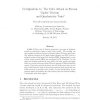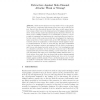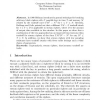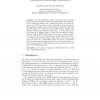129
click to vote
IACR
2011
14 years 5 days ago
2011
We describe a systematic framework for using a stream cipher supporting an initialisation vector (IV) to perform various tasks of authentication and authenticated encryption. These...
95
Voted
IACR
2011
14 years 5 days ago
2011
In 2008 I. Dinur and A. Shamir presented a new type of algebraic attack on symmetric ciphers named cube attack. The method has been applied to reduced variants of stream ciphers T...
135
Voted
CHES
2011
Springer
14 years 15 days ago
2011
Springer
Randomness extractors are important tools in cryptography. Their goal is to compress a high-entropy source into a more uniform output. Beyond their theoretical interest, they have ...
106
click to vote
ICISC
2004
15 years 1 months ago
2004
Algebraic attacks on stream ciphers [14] recover the key by solving an overdefined system of multivariate equations. Such attacks can break several interesting cases of LFSR-based ...
ICISC
2004
15 years 1 months ago
2004
This paper presents Dragon, a new stream cipher constructed using a single word based non-linear feedback shift register and a nonlinear filter function with memory. Dragon uses a ...
123
Voted
ASIACRYPT
2000
Springer
15 years 4 months ago
2000
Springer
In 1980 Hellman introduced a general technique for breaking arbitrary block ciphers with N possible keys in time T and memory M related by the tradeoff curve TM2 = N2 for 1 T N. ...
117
Voted
FSE
2006
Springer
15 years 4 months ago
2006
Springer
The main application of stream ciphers is online-encryption of arbitrarily long data, for example when transmitting speech data between a Bluetooth headset and a mobile GSM phone o...
97
Voted
EUROCRYPT
2006
Springer
15 years 4 months ago
2006
Springer
Sequence compression is one of the most promising tools for strengthening pseudo-random generators used in stream ciphers. Indeed, adding compression components can thwart algebrai...
108
Voted
CCS
2006
ACM
15 years 4 months ago
2006
ACM
Let us have an NLFSR with the feedback function g(x) and an LFSR with the generating polynomial f(x). The function g(x) is a Boolean function on the state of the NLFSR and the LFS...
124
Voted
ASIACRYPT
2006
Springer
15 years 4 months ago
2006
Springer
Abstract. Stream ciphers play an important role in symmetric cryptology because of their suitability in high speed applications where block ciphers fall short. A large number of fa...




